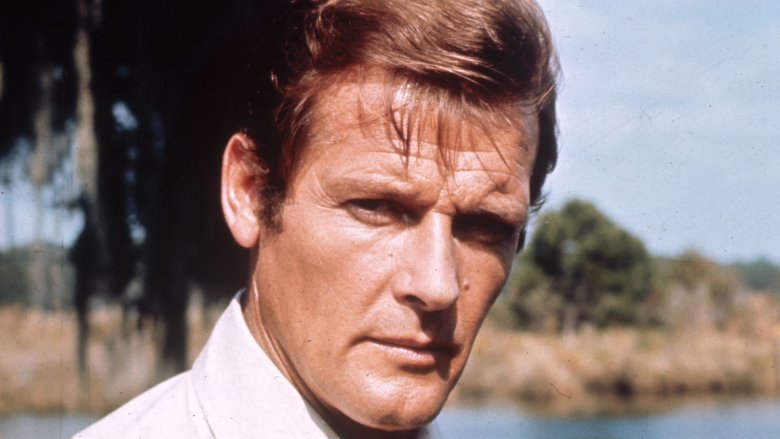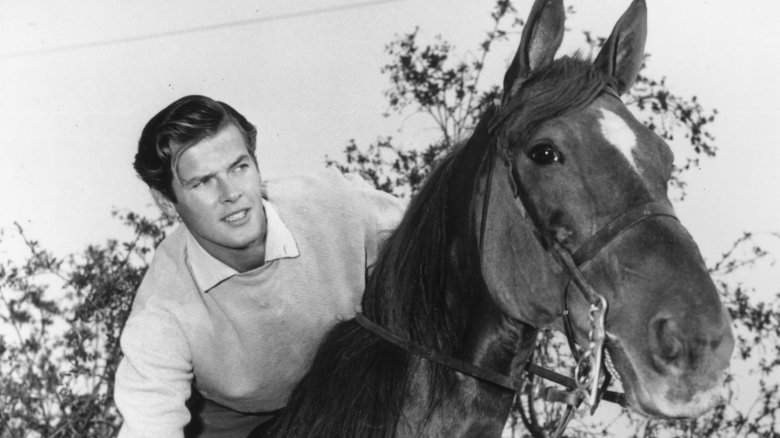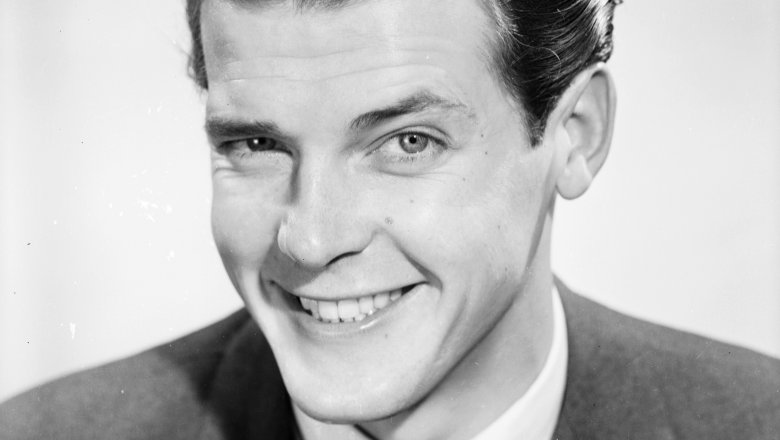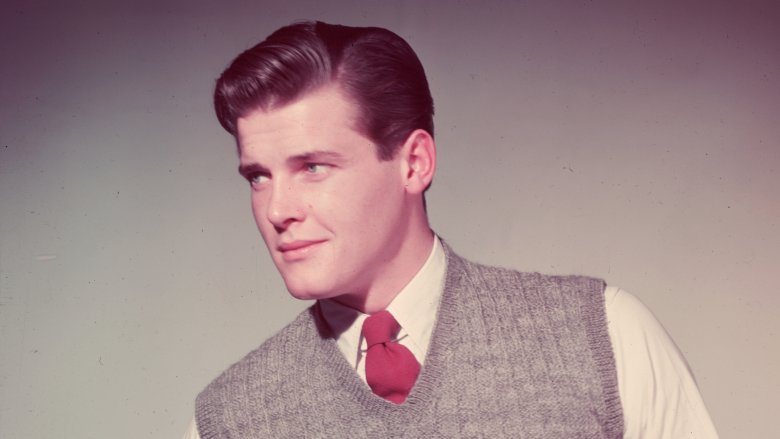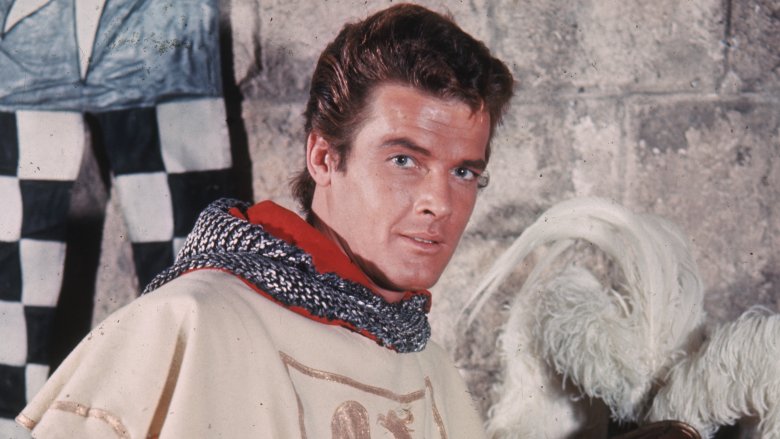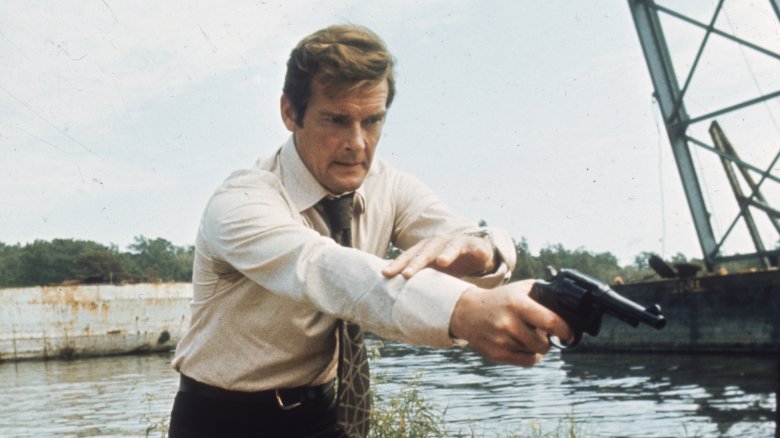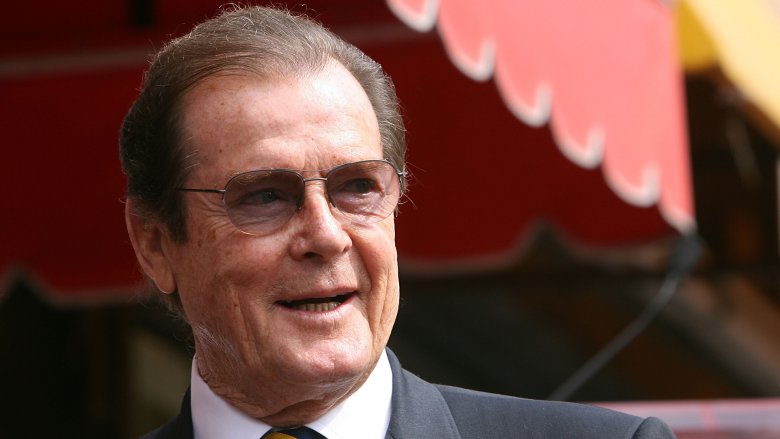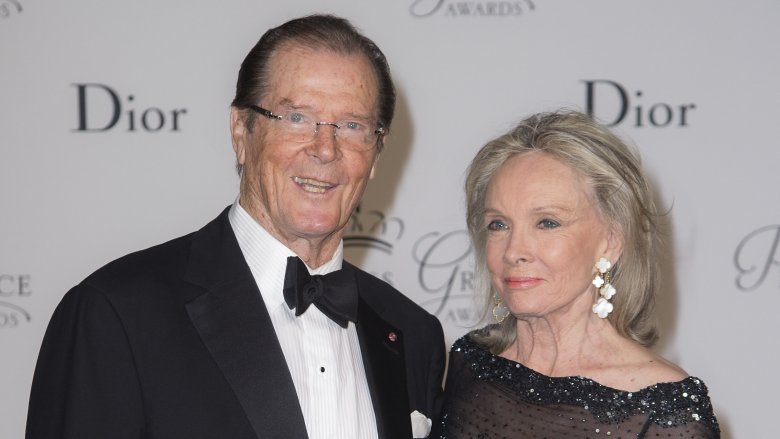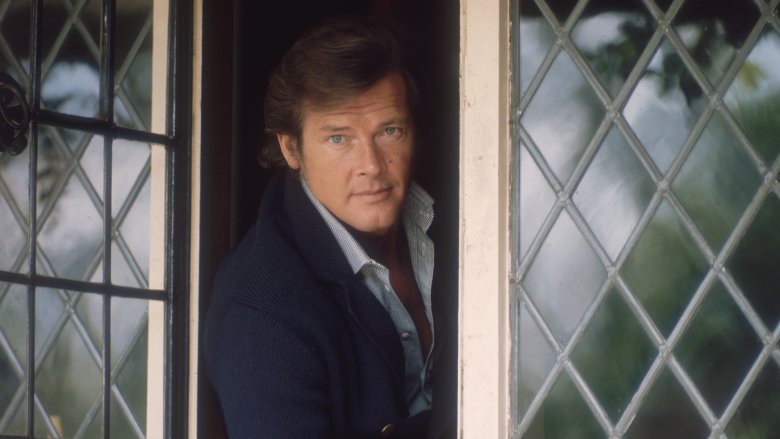The Untold Truth Of Roger Moore
Former James Bond star Sir Roger Moore has passed away at the age of 89, after a short battle with cancer. His passing was confirmed on May 23, 2017 via a statement posted to his official Twitter account. "We know our own love and admiration will be magnified many times over, across the world, by people who knew him for his films, his television shows and his passionate work for UNICEF which he considered to be his greatest achievement," wrote Moore's family. "Thank you Pops for being you, and for being so very special to so many people." The star will be given a private funeral in Monaco, according to his wishes.
Although many know Moore for his work from his role as 007 in seven James Bond films throughout the '70s and '80s, his life and legacy are much more than that. Here's a look back at the life of Roger Moore, and the events that shaped him into the man he was.
Operation Pied Piper
Moore was born in 1927 to policeman George Alfred Moore and his wife, Lillian "Lily" Pope. He grew up in south London, attending school at Battersea Grammar School. During World War II, Moore was one of the many thousands of school-aged London children evacuated to other parts of Great Britain because of the threat of German bombing, in a move known as "Operation Pied Piper."
Moore was evacuated to Holsworthy, Devon, a period he would later recall with great fondness: he spent several months in the Cornwall area, enrolling in the local Launceston College at age 13, and later at Dr. Challoner's Grammar School. Once the threat of bombing had been lifted, Moore returned home to London and continued his education at the College of the Venerable Bede. He didn't finish, though; instead, he dropped out at age 15 to take a job working as a tracer and office boy at the animation and film studio Publicity Picture Productions. The studio fired him not long after, leaving Moore to decide where life would take him next.
Royal Academy and Royal Army
When he was still a teen, Moore and some of his friends auditioned to be extras in the movie Caesar and Cleopatra, starring Vivien Leigh and Claude Rains. Moore was given a role as a Roman legionnaire, and became friends with the film's assistant director, Brian Desmond Hurst. Several years later, Moore would take a small part for £5 per day in another one of Hurst's movies—1949's Tottie True—alongside fellow future British film star Sir Christopher Lee.
In 1944, Hurst suggested to Moore that he should attend the drama program at the Royal Academy of Dramatic Art, and after Moore successfully auditioned for the program, Hurst even paid for his tuition at RADA for three terms. One of his classmates at RADA was none other than Lois Maxwell, who would later play the original Miss Moneypenny in the Bond films. After graduating the program and turning 18, Moore was called up in 1946 to join the Royal Army Service Corps. He also married fellow RADA student Doorn Van Steyn that year. Moore stayed in the military for three years, eventually working for the CSE, which arranged shows and entertainment for soldiers abroad.
The Big Knit
After leaving the army in 1949 and joining a repertory theater making just £10 a week, Moore earned extra money through modeling—mostly posing in outfits for various knitwear companies. He was also a featured model for dozens of other home and personal health products, from Brylcreem to Macleans toothpaste. Because Moore appeared in so many male fashion catalogs and knitting pattern sleeves during the early '50s, his sideline occupation eventually earned him the nickname "The Big Knit" around town.
No bloody good
In 1954, Moore scored a seven-year contract with Metro Goldwyn Mayer studios, but had a hard time landing meaty parts with the big Hollywood studio. Worse yet, the movies he did appear in at MGM—including The Last Time I Saw Paris (1954), Interrupted Melody (1955), The King's Thief (1955) and Diane (1956)—were all financial flops. As Moore later famously explained, "At MGM, RGM (Roger George Moore) was NBG [no bloody good]." The studio released him after just two years in his contract.
By the mid '50s, Moore switched tacks (and studios), trying his hand at acting for television and signing a contract with Warner Brothers. He starred in a string of roles in TV shows between 1958 and 1961, including Ivanhoe, The Alaskans, and Maverick. In 1962, Moore would score his breakout role, appearing as Simon Templar in the popular series The Saint—a part he'd play for seven years.
Becoming "Bond, James Bond"
Moore's long-running part in the spy thriller television series The Saint prepared him to take over for original big-screen Bond Sean Connery, but only when Connery was ready to step down. In the meantime, Moore happened to meet Bond producers Albert "Cubby" Broccoli and Harry Saltzman while playing chemin de fer at a London casino. The stage was set, and it was nearly time for the curtain to go up.
Connery exited the franchise in 1971 with Diamonds are Forever, and producer Albert Broccoli offered Moore the part in 1972—as long as he cut his hair and lost some weight. Moore would later playfully tell Entertainment Weekly about his reaction to the requirements, saying "Couldn't you get a thin, bald man to start with?" Moore would go on to star in seven Bond films between 1973 and 1985, including Live and Let Die, The Man with the Golden Gun, The Spy Who Loved Me, Moonraker, For Your Eyes Only, Octopussy, and A View to a Kill.
Towel thief
After achieving worldwide fame as the star of the Bond franchise, Moore often found himself tiring of answering the same old questions during every press event or interview he gave. To keep from dying of boredom, he started playing a one-sided game with reporters, as he explained in his memoir, Bond on Bond. "I often used to amuse myself by slipping in statements, such as the best thing about location work was that I could steal the hotel towels, or that I did all my own stunts apart from the sex scenes..."
Unfortunately, Moore eventually had to put a stop to his game when the interviewers took him seriously, with one British paper going so far as to print a story entitled "Roger Moore is a towel thief." The anecdote became a legend, even making it into BBC radio comedy programs. Moore never lost his sense of humor about the tale, and managed to convince Graham Norton in a 1999 interview that he still had his towel collection at home. In a 2008 interview with Reuters, he finally came clean about the myth: "It was a load of ... (nonsense)!"
Charity work and knighthood
In 1991, Moore became a UNICEF Goodwill Ambassador, using his celebrity to bring attention to the humanitarian cause through appearances and personal visits. In 2011, UNICEF honored Moore for his 20-year dedication to the cause, and shed a little more light on his impact: "Since his appointment as a Goodwill Ambassador in August 1991, Sir Roger has visited UNICEF-supported programs around the world, bringing attention to children's needs and enlisting widespread public support and donations. He has given compelling voice to a range of issues, from HIV/AIDS to landmine injuries, disability rights, iodine deficiency and more."
Moore was involved in launching the partnership between UNICEF and FIFA, the governing body for football worldwide. He also promoted the Kiwanis International's Worldwide Service Project, which focuses on eliminating iodine deficiency around the world—a leading cause of brain damage. The Kiwanis honored Moore with their World Service Medal, and he also received the German Federal Service Cross in 2003 and the Dag Hammarskjöld Inspiration Award in 2007. In 1999, England honored Moore by naming him a Commander of the Order of the British Empire, and Queen Elizabeth II knighted him at a 2003 ceremony falling on her birthday.
Tumultuous love life
While Moore married his first love—RADA classmate Doorn Van Steyn—in 1946, the marriage proved short-lived. The pair divorced by 1952, and Moore married again to Welsh singer Dorothy Squires in 1953. Again, the relationship wouldn't last long; Squires and Moore separated nine years later. Squires refused to grant Moore the divorce he wanted until 1969, but he didn't stay single long, immediately marrying Italian actress Luisa Mattioli, whom he'd been seeing since 1961. The couple had three children—Deborah, Geoffrey, & Christian. Mattioli and Moore would eventually go through a contentious breakup in 1993, with Mattioli also refusing to grant Moore a divorce until 2000. Perhaps for Moore, the fourth time was the charm; he married Kristina "Kiki" Tholstrup in 2002, and the pair remained together until his death in 2017.
Moore described his previous three marriages as tumultuous, and even did a tell-all interview with ITV alleging physical abuse at the hands of Squires, who he accused of smashed a guitar over his head in a fit of rage. In contrast, Moore described his marriage to Tholstrup as "a tranquil relationship, there are no arguments," and called his wife Kristina "organized," "serene," "loving," and "calm."
His health and passing
The family statement about Moore's passing indicated he'd fought a brief battle with cancer—which wouldn't be his first major health problem. In 1993, he was diagnosed with prostate cancer, which he called "rather painful and, in many ways, life-changing." Moore was later diagnosed with Type II Diabetes in late 2013, which left him unable to drink alcohol—including Bond's favorite mixed drink, the vodka martini. He also struggled with a bout of pneumonia and collapsed on a Broadway stage, prompting doctors to fit him with a pacemaker.
Every time he was knocked down by illness, however, Moore managed to get back up again and keep going. In a 2014 interview, he told The Telegraph that "when I'm told I've got 24 hours to go, I'm going to have a couple of dry martinis with Tanqueray gin—not vodka—and a couple of choc ices with plain chocolate on the outside and white, white vanilla on the inside—oh, and baked beans." Here's hoping he was able to sample some of those favorite indulgences before his passing.
Whether you remember him as the Saint, James Bond, or one of his other many roles, there's no question that Sir Roger Moore left a large imprint on the hearts of his fans—and an even larger legacy.
